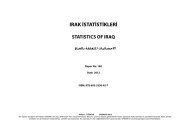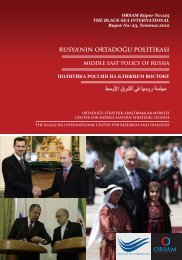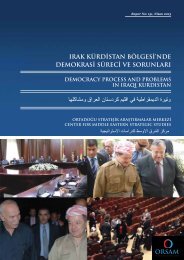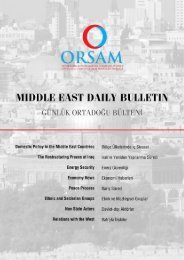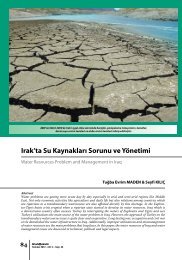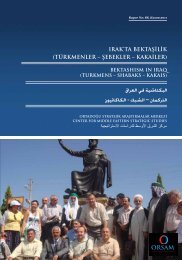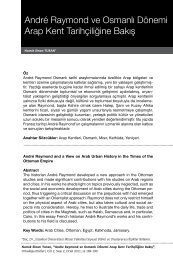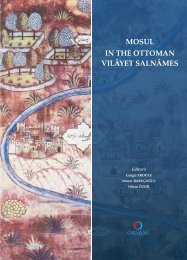30 July - 5 August 2012 - orsam
30 July - 5 August 2012 - orsam
30 July - 5 August 2012 - orsam
You also want an ePaper? Increase the reach of your titles
YUMPU automatically turns print PDFs into web optimized ePapers that Google loves.
4- How to? Resource development. Resource Efficiency. Alternative paths to sustainability.<br />
5- Benefits of regional cooperation for sustainability: in food production, energy, research and<br />
development.<br />
Between 25-<strong>30</strong> April, AFED organized regional consultations (in Cairo, Beirut and Amman) to<br />
discuss preliminary findings.<br />
MAIN FINDINGS OF THE GFN ARAB FOOTPRINT SURVEY<br />
The results for the Arab region Ecological Footprint survey are critical for understanding the region‘s<br />
competitive advantages and disadvantages. Here are highlights of the findings:<br />
* The average Ecological Footprint per capita in the Arab region increased 85 percent, from 1.2 gha<br />
to 2.2 gha per capita, between 1961 and 2008<br />
* Population has increased 250 percent over the same period; the overall regional Ecological<br />
Footprint has therefore increased more than 500 percent.<br />
* Between 1961 and 2008, the available biocapacity per capita in the Arab region decreased 60<br />
percent, from 2.2 gha per capita to 0.9 gha per capita<br />
* 4 nations alone contribute more than 50 percent of the Arab region‘s Ecological Footprint: Egypt<br />
(22 percent), Saudi Arabia (14 percent), UAE (10 percent), and Sudan (9 percent)<br />
* Only 2 nations provide approximately 50 percent of the biocapacity of the Arab region: Sudan (32<br />
percent) and Egypt (17 percent)<br />
* Since 1979 the region has been in a situation of biocapacity deficit, with its demand for ecological<br />
services increasingly exceeding its supply. In order to maintain this situation, the import of ecological<br />
services from outside the region‘s borders was necessary.<br />
* Other than in the GCC countries, the average inhabitant‘s Footprint is small compared to the rest of<br />
the world, and in many cases it is too small to meet basic food, shelter, health and sanitation needs. In<br />
order to make vital quality of life improvements, large segments of the region‘s population must have<br />
greater access to renewable natural resources. Meeting this need will involve multiple strategies:<br />
large improvements in resource efficiency; expansion of biocapacity without resource intensive<br />
production; and, since it is likely that the Ecological Footprint of this region will then rise, a<br />
corresponding decrease in the Ecological Footprint of other regions will be required.<br />
Page 84




